Occasionally I rerun an older post that most current blog followers have never seen. This one was published just short of eight years ago. For this version I’ve edited the text, tweaked the formatting and changed the title.
I photographed this pair of coyotes up close as they hunted voles along the Antelope Island causeway.
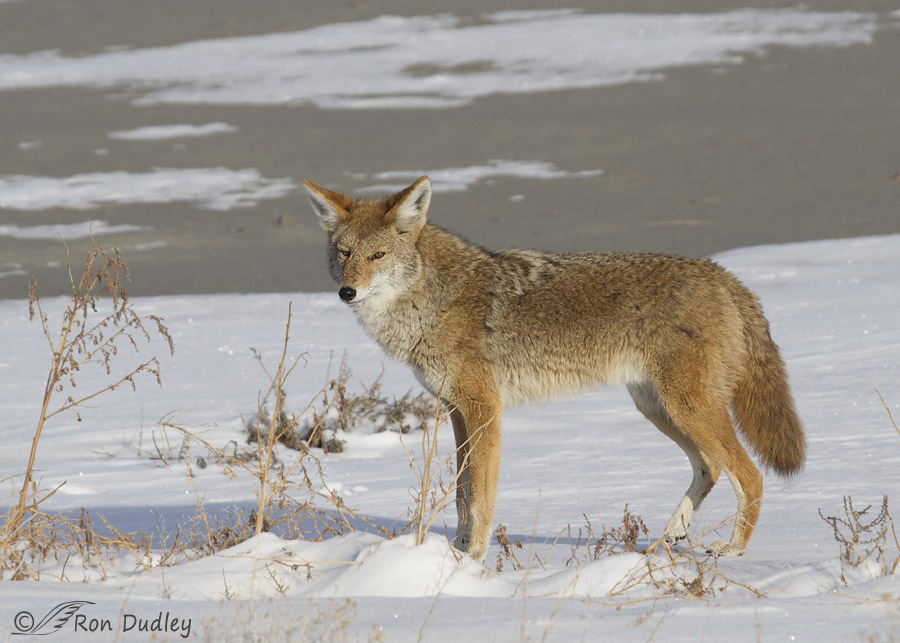
1/2000, f/7.1/ ISO 500, Canon 7D, Canon 100-400 @ 310mm, not baited, set up or called in
When they’re on the island itself coyotes usually don’t allow such a close approach but the causeway is narrow and loaded with voles so the coyotes sometimes tolerate the nearby traffic and go about their business. I was close enough that I had to use my smaller zoom lens for this sequence.
Both coyotes studiously avoided looking at me, though they were keenly aware of my presence. I had to stoop to trickery to get anything that resembled eye contact. Here the coyote had been looking behind it with its head turned backward to my right. In order to get a look at its eyes I deliberately timed a burst of shots as it was in the process of turning its head to look forward again. I did catch a glimpse of its eyes but it isn’t really looking at me or my pickup.
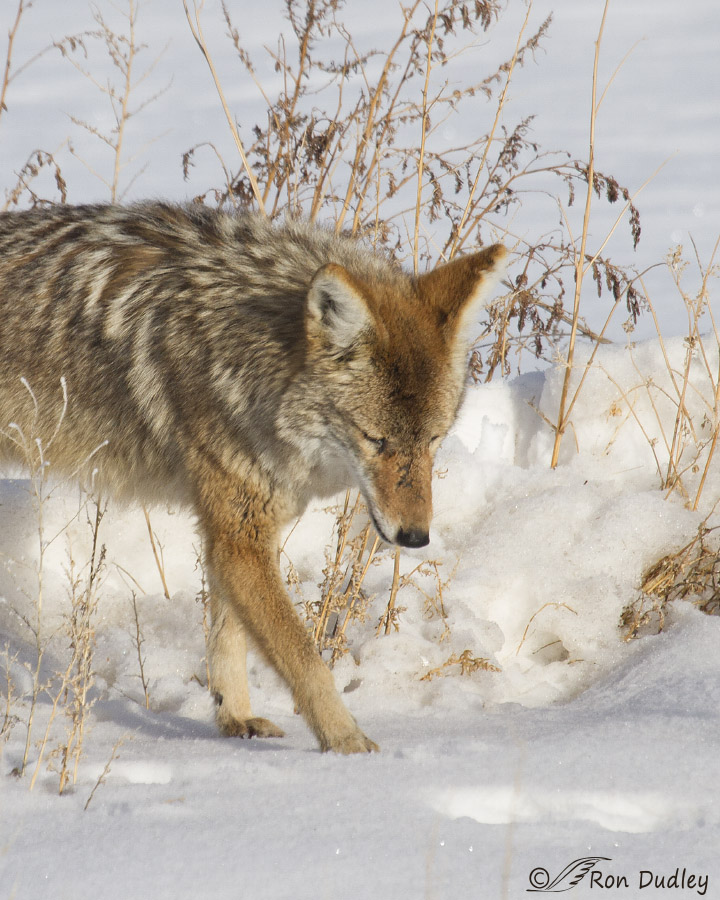
1/2000, f/7.1/ ISO 500, Canon 7D, Canon 100-400 @ 390mm, not baited, set up or called in
This is the other coyote. I recognize this one because of the distinctive Z-shaped scar on top of its snout. I sometimes call this coyote Zorro.
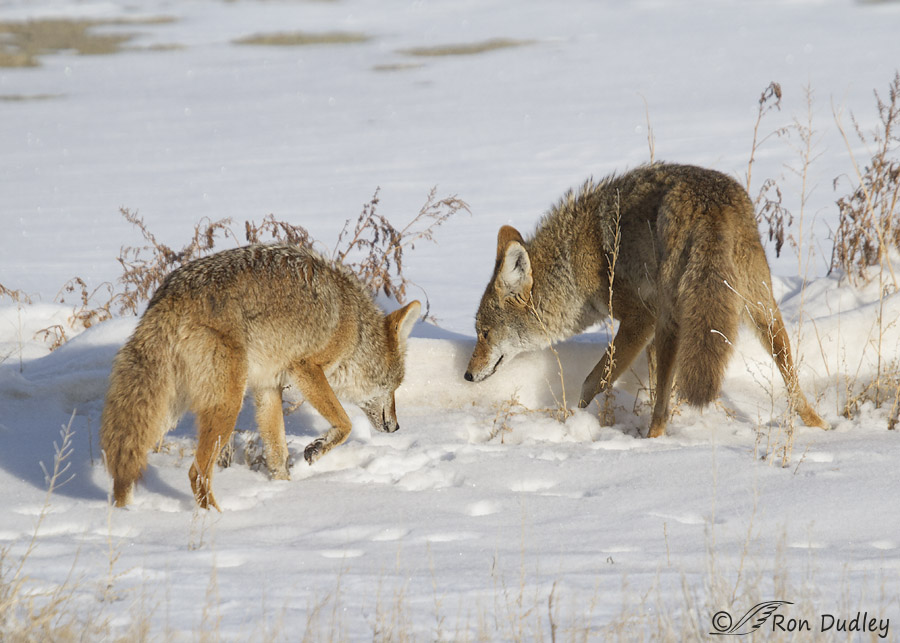
1/3200, f/5.6/ ISO 500, Canon 7D, Canon 100-400 @ 300mm, not baited, set up or called in
Coyotes typically hunt voles by smell. They’re very, very good at detecting the smell of vole urine near their burrows, even when covered with snow. Here both coyotes are investigating a potential rodent meal under the snow.
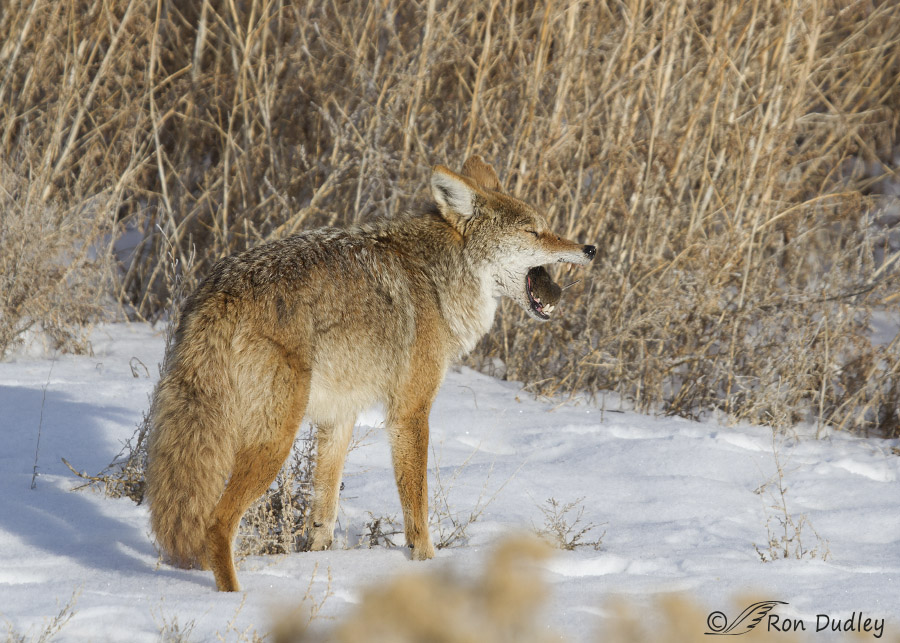
1/1600, f/7.1/ ISO 500, Canon 7D, Canon 100-400 @ 260mm, not baited, set up or called in
This coyote mostly had its back to me when it snagged a plump vole from beneath the snow but occasionally, while it was chomping it down, the coyote turned slightly to give me a look at the rodent as it was about to go down the chute.
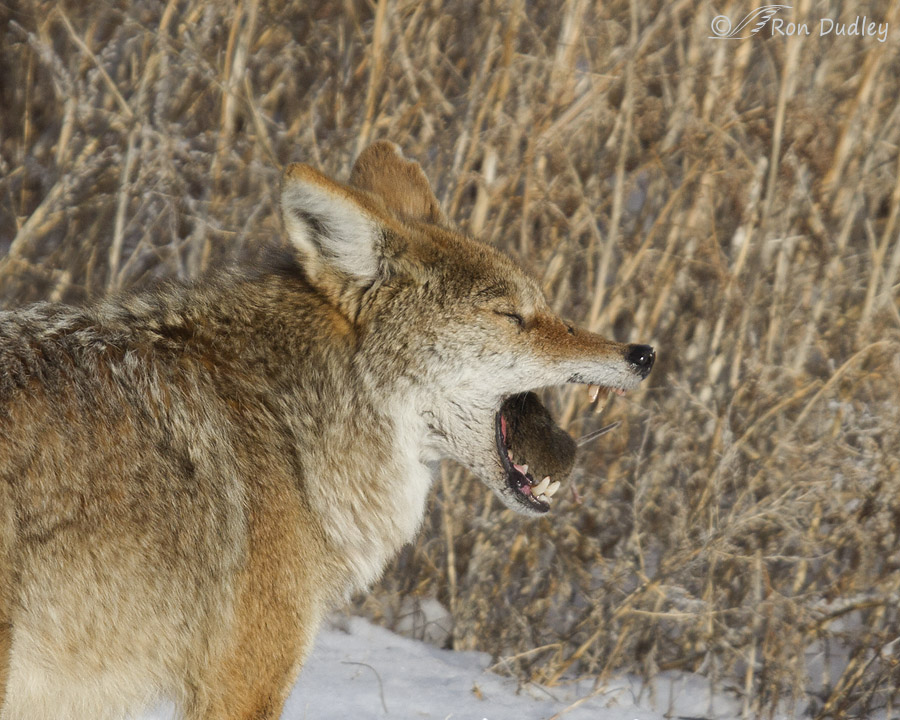
A large crop of the same image reveals that it almost looks like the vole is standing up on the floor of the coyotes mouth and investigating the path that it was about to follow down the throat.
Photos like this one make me appreciate the involuntary sacrifice many voles make for the greater good.
Ron
PS – And speaking of “dogs” – beginning with today’s post his old dog (me) is attempting to learn a new trick. Ever since I began learning to type in high school in 1961 I’ve been putting two spaces between sentences but yesterday (1/7/15) I learned that it’s now proper to have only one. Yep, I can be a slow learner.
Hopefully this is a habit I’ll be able to break. Apologies to those of you who have winced painfully as you’ve read my blog posts in the past.


I absolutely love the shots.
There is no way that anyone could get that close to photograph a Coyote here in the East. We hear them howl at night, especially in the Winter, but there are too many here that want to shoot em for Coyotes to show themselves.
I’ve honestly never stopped to count your spaces. Irregardless (which STILL shouldn’t be a word) you continue to amaze me. That vole shot is WOW.
Good shots Ron. Really a big fan of coyotes and we sure have plenty here. On our golf course they eat gophers. They can hear them and when they pop up or are close to the surface the coyotes leap through the air to catch them. Very skilled at it. No problem whatsoever looking at predators eating prey – just what nature is, and of course we once did it ourselves long before supermarkets etc. Hope you had a good and pain free Thanksgiving.
Thank you, Everett.
Nice photos as usual. I think sometimes those voles go down after one or two chomps.
Good to see you today!
I enjoyed seeing you too, April. I just wish we’d been in the field while we visited.
Oh my gosh, so MANY things to consider and comment upon! 😂
First, I appreciate your photos, the coyotes’ survival skills and the voles’ ultimate sacrifice for the good of the order, but I really can’t look at those last pics. “Critters gotta eat, I don’t gotta watch.”
I was a publications editor for years, forced into the single-space-after-period format by the graphic designer(s) I worked with long ago. I resisted in other places (city council reports, correspondence) until it was clear resistance was futile. And now, as a volunteer editor of a newsletter, I find myself whacking with abandon at those extra spaces in articles submitted by others. Oh the irony. 🙄
Chris, my views on the matter have gone through similar ironic twists and turns. A friend of mine had this to say on FB about today’s post. I thought it was a very interesting comment.
“The double space is a dead giveaway of the typographer’s age and training. Use of the double space indicates having learned on a typewriter vs. a keyboard.
For anyone trying to avoid ageism while applying for a job and inadvertently disclosing one’s age, I highly recommend NOT using double spaces – including after a colon – in any resumes, cover letters, etc.
As someone who is a desktop publishing subject matter expert (I format documents in a highly regulated industry), those extra spaces are unnecessary and add up in long documents. They are also not used in other languages and do not affect readability.
There also used to be an old school theory that serif fonts were easier to read. That theory has also been debunked over the years.”
Yup, us old-school types (not calling us geezers) are easily discerned in so many ways — in writing, particularly. I’m STILL having a very hard time with the use of “they” when referring to an individual raptor (not a human!) whose sex is uncertain. As if said raptor might be offended? I’ve been trying “s/he” but afraid I’m never gonna win that battle, either. 😑
Call me a rebel. I still put two spaces after each full stop. And have no intention of trying to change.
Poor vole. And all its relatives who also (unwillingly) make that final sacrifice. I know it is necessary but…
And WP can fix my error all it likes. I know that extra space is there.
“WP can fix my error all it likes. I know that extra space is there”
I like your attitude, EC – big time.
I do hope (and will check) that WP doesn’t take it on itself to Americanise my spelling…
Good!
“I do hope (and will check) that WP doesn’t take it on itself to Americanise my spelling…”
The “horrour!” 😈😂
😁
We do love to amuse ourselves, don’t we? We do! 😂😉
Oh. Em. Gee. People will complain about anything, won’t they? (I’ve noticed before that WordPress deletes my 2nd post-period space, so I’m trying three spaces to see what happens. 😈) #twospacesforlife! 😉
Poor Voley-vole, though I’m glad the Coyotes are eating. I also noticed that shorter canine and wonder if it happened at the same time as Zorro received his unusual scar. I used a Food Web worksheet that included voles and my students would always ask what voles were, as the primary vole species in CA is often called a meadow mouse and isn’t found very often near the coast.
Well, 3 spaces was a bust. WordPress — it KNOWS! 🙀😹
“People will complain about anything, won’t they?”
They sure will, Marty. As an example, this is part of a comment a good friend of mine made on this post on Facebook: “When we were at Bryce Canyon a few years ago, at one of the overlooks, admiring those stunning vistas, I heard someone complaining that the sidewalks were dirty.”
Haha! Yes: a number of years ago, my husband, Dan Gleason, and I were visiting the Oregon Caves National Monument. As we were hiking near the parking lot where RVs and day use visitors parked when they took the cave visit, we overheard a conversation. A fellow dressed in a t-shirt (it was a nice warm summer day) was loudly lamenting and expounding to all nearby ears that, “Why in the heck do t they turn the heat up in the damn cave! Telling us it’s only 40 degrees inside! Good grief, turn the heat on!” Grumble, grumble!
I hope that guy wasn’t the driver of one of those huge RVs, Barbara – not smart enough.
Why I’m *never* shocked to see the YT videos of idiots closing in on bear, bison, elk or moose for the epic vacation photo.
Loved the photos even though with the tension between the coyote’s need to eat to live and the vole’s imminent departure.
I recall my disbelief 15 years ago when my report was returned by our company’s new tech editor with his removal of a space at the end of all my paragraphs. It took a while for me to adapt, and I’m not sure if I ever fully have adhered to the new “rule”. I have never noticed anything wrong with your sentences ending – they seemed natural.
“It took a while for me to adapt”
Me too, Kent. But now, two spaces between sentences looks out of place to me.
“…the involuntary sacrifice many voles make for the greater good.” I don’t think I’ve read a better definition of the food chain in general.
One is tempted to ascribe a couple of reactions to the look of the Coyote in the last photo: delicious, or disgusting, but most likely just hungry and makin’ a livin’.
I read about the one space rule a while ago. The only thing it’s done for me is often having to go back and delete the second space as I’m semi-successfully checking all my other typos; as your linked article says, it was manual typewriters what done it; I took a typing class in high school circa 1965.
Lyle, following is evidence that I wasn’t so bright during high school
One of the main reasons I took typing in HS was because the teacher (Miss Schwingel) allowed the class to listen to the World Series on the radio during class (she was a sports nut, eventually marrying one of the coaches). As soon as the Series was over I dropped the class, before I could really type. Then I forgot what little I learned.
So when computers began to become essential in the 80’s, especially for teachers, I had to teach myself how to type. It was a monumental struggle!
I had a big fight with my mom over taking typing. I wanted to take an art class, but she insisted and my dad (who typed pretty quickly with 3 fingers) backed her up. I’ve never been so grateful to lose a fight with my mom. As I was taking notes during college, I wished she had forced me to take shorthand the 2nd semester too.
Marty, dropping that class was one of the dumbest things I’ve ever done and I’ve done a few. I had terrible handwriting but for the first 15 years or so I was teaching I had to handwrite all of the quizzes and tests I gave to my students. And then there was the mimeograph machine…
Great series! In the last photo it looks like the tip of the upper right canine tooth might be broken, what do you think? It most likely won’t cause the coyote any problems unless the root becomes exposed and then it could be painful.
I dunno, Cindy. It’s hard for me to tell about that tooth, but maybe.
Nice series on these coyotes. I have never seen them on AI.
By the way who cares how many spaces between sentences I am here to view your fabulous images and learn from them !! Gary
Gary, apparently some people care and really don’t like the two spaces.
Nice shots of the coyotes! 🙂 Our Border Collie does the same thing even when there isn’t snow – amazing what she can detect!
Probably “ain’t happenin’ ” on the spacing between sentences tho I applaud your efforts to “modernize”….. 😉
Thanks, Judy.
I always wondered how predators like the Coyote could find prey under the snow; for getting the keen sense of smell all canines possess.
They can get used to working among humans. Though I live is a Los Angeles neighborhood, we occasionally see one casually walking down the street.
On a side note, I like my two spaces and I’m sticking with them. What a wonderful world it would be if this issue were really a thing to fret about.😊
MIchael, It’s funny. WordPress will allow me to leave two spaces in my text but it won’t allow readers two spaces in their comments – it ‘fixes’ them. So your presumed two spaces aren’t there in your comment.
Right up there with spell check that doesn’t always work so well…….. 😉 I hadn’t noticed what WP did……..
That is absolutely amazing and it makes me want to see the rest of the series.